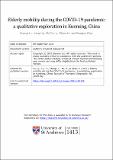Files in this item
Elderly mobility during the COVID-19 pandemic : a qualitative exploration in Kunming, China
Item metadata
| dc.contributor.author | Liu, Qiyang | |
| dc.contributor.author | Liu, Yang | |
| dc.contributor.author | Zhang, Chi | |
| dc.contributor.author | An, Zihao | |
| dc.contributor.author | Zhao, Pengjun | |
| dc.date.accessioned | 2023-02-26T00:43:48Z | |
| dc.date.available | 2023-02-26T00:43:48Z | |
| dc.date.issued | 2021-10-01 | |
| dc.identifier | 275681839 | |
| dc.identifier | 19d5d867-6231-4490-a71d-59ea53584a6b | |
| dc.identifier | 85107717376 | |
| dc.identifier | 000704592700008 | |
| dc.identifier.citation | Liu , Q , Liu , Y , Zhang , C , An , Z & Zhao , P 2021 , ' Elderly mobility during the COVID-19 pandemic : a qualitative exploration in Kunming, China ' , Journal of Transport Geography , vol. 96 , 103176 . https://doi.org/10.1016/j.jtrangeo.2021.103176 | en |
| dc.identifier.issn | 0966-6923 | |
| dc.identifier.other | RIS: urn:56BB083129942CFDBC74CD1988073A2F | |
| dc.identifier.other | ORCID: /0000-0003-3881-0546/work/99466618 | |
| dc.identifier.uri | https://hdl.handle.net/10023/27062 | |
| dc.description | Funding: National Natural Science Foundation of China (41925003), Beijing Social Science Foundation (18JZD029), UKRI’s Global Challenge Research Fund (No. ES/P011055/1) and Ministry of Education Key Projects of Philosophy and Social Sciences Research (No. 18JZD029). | en |
| dc.description.abstract | The outbreak of COVID-19 in China started at the end of December 2019. This led to a series of containment measurements to control the spread of COVID-19. Despite of the widely reported effects of these measures, inadequate attention has gone to their social impacts. The elderly, as one of the most susceptible populations, has experienced a considerable reduction in mobility. This paper explores the role mobility played and how the social environment influenced elderly mobility in the first 2 months of the COVID-19 outbreak. We surveyed 186 families with a total of 248 elderly people in Kunming. The results show that mobility improves the quality of daily living, such as access to grocery shopping, maintenance of outdoor activities for health cultivation and preserving social networks even during the pandemic. Four themes relating to social environment emerged from the data as elements influencing elderly mobility during the pandemic: social pressure, practice of the virtue of Xiao, the social norm of respecting the aged and the impacts of technological advances. Among them, the virtue of Xiao enabled the elderly to stay in place in the early phase of COVID-19 by fulfilling their needs for daily necessities and social interactions, whilst being less technology-savvy further excluded them socially by restraining them from restoring mobility after the lifting of travel restrictions. | |
| dc.format.extent | 13 | |
| dc.format.extent | 917805 | |
| dc.language.iso | eng | |
| dc.relation.ispartof | Journal of Transport Geography | en |
| dc.subject | Elderly mobility | en |
| dc.subject | Social environment | en |
| dc.subject | Xiao | en |
| dc.subject | Technology-driven transport-related social exclusion | en |
| dc.subject | COVID-19 | en |
| dc.subject | RA Public aspects of medicine | en |
| dc.subject | NDAS | en |
| dc.subject | SDG 10 - Reduced Inequalities | en |
| dc.subject | AC | en |
| dc.subject | MCC | en |
| dc.subject.lcc | RA | en |
| dc.title | Elderly mobility during the COVID-19 pandemic : a qualitative exploration in Kunming, China | en |
| dc.type | Journal article | en |
| dc.contributor.institution | University of St Andrews. School of International Relations | en |
| dc.identifier.doi | 10.1016/j.jtrangeo.2021.103176 | |
| dc.description.status | Peer reviewed | en |
| dc.date.embargoedUntil | 2023-02-26 |
This item appears in the following Collection(s)
Items in the St Andrews Research Repository are protected by copyright, with all rights reserved, unless otherwise indicated.

